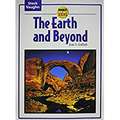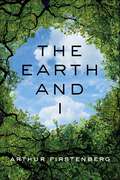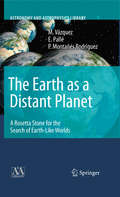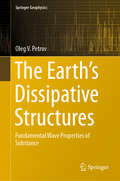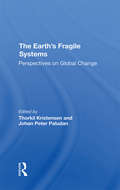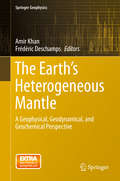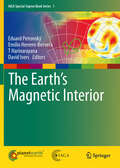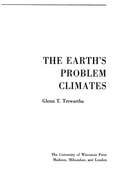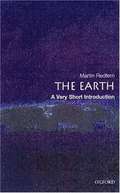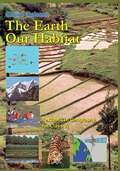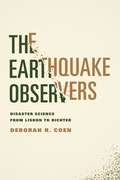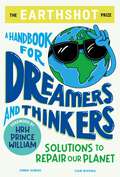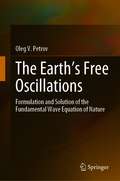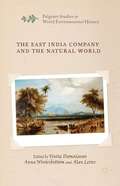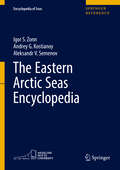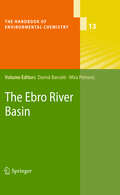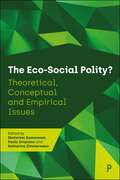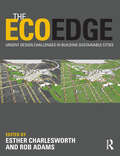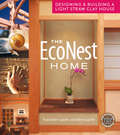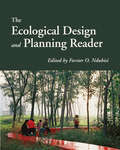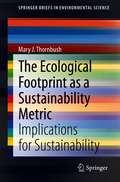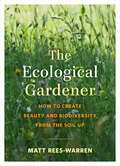- Table View
- List View
The Earth and Beyond (Wonders of Science)
by Joan S. GottliebScience textbook for children, about the planets in the solar system.
The Earth and I
by Arthur FirstenbergAlmost all environmental books treat the environmental crisis as though humans are in charge of nature, rather than part of it. The Earth and I is the first book to put all preconceived notions aside and to ask, naïvely: Who are we really? What is our relationship to the earth? How is it possible that we, out of all the millions of species, have come to destroy our common home? The answers are surprising and have far-reaching implications for those searching for solutions. Part One tells what is happening to the earth&’s systems and how they are being destroyed. It rewrites the two-million-year history of humanity&’s tenure on the earth as if we are part of nature and not separate from it, and describes both the earth and the universe as living systems. It paints a global, coherent picture of the devastation to Earth&’s air, water, forests, and creatures that is not found elsewhere. It reviews assaults on these systems that are not treated adequately, if at all, elsewhere: chemicals; radiation; plastics; detergents; biocides; noise; cars; and guns. Part Two, &“Digging below the Surface,&” asks why, and enters territory not previously explored by environmentalists. It describes the various ways to make a living on the earth—hunting and gathering, shifting agriculture, nomadic herding, settled agriculture, and industrial technology—as choices, not eras—choices coexisting with one another until today. It rewrites economics. It explores the relationship of warfare, slavery, religion, and human sexuality to the environmental crisis. And it is forced to conclude that these aspects of human culture are not only shaped, but created by the technologies we use; that the use of non-human sources of energy interferes with human psychological development; and that the unfulfilled urges within us explode in the violent technologies that are destroying our planet. The solutions, if it is not too late, therefore lie in wise choice, rather than wise use, of our technologies.
The Earth as a Distant Planet
by E. Pallé P. Montañés Rodríguez M. VázquezIn The Earth as a Distant Planet, the authors become external observers of our solar system from a distance and try to determine how one can understand how Earth, the third in distance to the central star, is essentially unique and capable of sustaining life. The knowledge gained from this original perspective is then applied to the search for other planets outside the solar system, or exoplanets. Since the discovery in 1992 of the first exoplanet, the number of planet detections has increased exponentially and ambitious missions are already being planned for the future. The exploration of Earth and the rest of the rocky planets are Rosetta stones in classifying and understanding the multiplicity of planetary systems that exist in our galaxy. In time, statistics on the formation and evolution of exoplanets will be available and will provide vital information for solving some of the unanswered questions about the formation, as well as evolution of our own world and solar system. Special attention is paid to the biosignatures (signs of life) detectable in the Earth's reflected spectra and the search for life in the universe. The authors are experts on the subject of extrasolar planets. They provide an introductory but also very much up-to-date text, making this book suitable for researchers and for advanced students in astronomy and astrophysics.
The Earth's Dissipative Structures: Fundamental Wave Properties of Substance (Springer Geophysics)
by Oleg V. PetrovThis volume describes physical, formal mathematical and exterior (morpho-structural) manifestations of wave dynamics of the Earth, defining both its deep structural image, and the external shape of planet. In addition to the standard imagination about waves in the geological environment as short-term seismological and seismic effects, wave dynamics of the Earth are considered as long-time process, comparable to the geochronological scale. The book consists of a systematic description of the conformities discovered in the set of heterogeneous and different-order objects, which have space-related regularity and recurrence at the different levels of resolution of analysis of natural systems. For expert-geologist it includes the basis of the geodynamic wave-related concept which enables to add to the traditional concept of plate tectonics, as well as the methods of quantitative interpretation of measured geo-fields.
The Earth's Fragile Systems: Perspectives On Global Change
by Thorkil Kristensen Johan Peter PaludanThe Earth's Fragile Systems is concerned with some of the most pressing and worrying of the problems afflicting our globe, problems that have been discussed in various forums and are well known not to be simple intellectually, practically or politically.
The Earth's Heterogeneous Mantle
by Amir Khan Frédéric DeschampsThis book highlights and discusses recent developments that have contributed to an improved understanding of observed mantle heterogeneities and their relation to the thermo-chemical state of Earth's mantle, which ultimately holds the key to unlocking the secrets of the evolution of our planet. This series of topical reviews and original contributions address 4 themes. Theme 1 covers topics in geophysics, including global and regional seismic tomography, electrical conductivity and seismic imaging of mantle discontinuities and heterogeneities in the upper mantle, transition zone and lower mantle. Theme 2 addresses geochemical views of the mantle including lithospheric evolution from analysis of mantle xenoliths, composition of the deep Earth and the effect of water on subduction-zone processes. Theme 3 discusses geodynamical perspectives on the global thermo-chemical structure of the deep mantle. Theme 4 covers application of mineral physics data and phase equilibrium computations to infer the regional-scale thermo-chemical structure of the mantle.
The Earth's Magnetic Interior
by David Ivers Eduard Petrovský Emilio Herrero-Bervera T HarinarayanaThis volume combines review and solicited contributions, related to scientific studies of Division I of IAGA presented at its Scientific Assembly in Sopron in 2009. The book is aimed at intermediate to advanced readers dealing with the Earth's magnetic field generation, its historical records in rocks and geological formations - including links to geodynamics and magnetic dating, with magnetic carriers in earth materials, electromagnetic induction and conductivity studies of the Earth interior with environmental applications of rock magnetism and electromagnetism. The aim of the book is to provide an overview of recent advances and future challenges in these particular fields of research.
The Earth's Problem Climates
by Glenn T. TrewarthaLatin America; Australia-New Zealand-Equatorial Pacific; Africa-Southern and Eastern Asia; Europe and the mediterranean Borderlands; Anglo-America.
The Earth: A Very Short Introduction
by Martin RedfernAround 30 years ago, two things happened that were to revolutionize the understanding of our home planet. First, geologists realized that the continents themselves were drifting across the surface of the globe and that oceans were being created and destroyed. Secondly, pictures of the entire planet were returned from space. Suddenly, the Earth began to be viewed as a single entity; a dynamic, interacting whole, controlled by complex processes we scarcely understood. This Introduction explores emerging geological research and explains how new advances in the understanding of plate tectonics, seismology, and satellite imagery have enabled us to begin to see the Earth as it actually is: dynamic and ever changing.
The Earth: Our Habitat class 6 - NCERT - 23
by National Council of Educational Research and Training"The Earth: Our Habitat" is a comprehensive textbook designed for sixth-grade students studying geography. This book delves into the intricate details of our planet, exploring various geographical aspects crucial to understanding Earth as our habitat. It covers diverse topics, such as the structure of the Earth, its landforms, climate patterns, natural resources, and the significance of environment conservation. The content is presented in a student-friendly manner, incorporating vivid illustrations, maps, and engaging exercises to facilitate better comprehension. The book aims to foster a deep appreciation for the Earth's complexity and its role as the ultimate home for all living beings. Through its detailed exploration of geography, "The Earth: Our Habitat" intends to instill a sense of responsibility among young learners towards preserving and nurturing the environment. Overall, it serves as a foundational guide, encouraging students to grasp the fundamental concepts of geography while emphasizing the importance of caring for our planet, ensuring a sustainable future for generations to come.
The Earthquake Observers: Disaster Science from Lisbon to Richter
by Deborah R. CoenEarthquakes have taught us much about our planet's hidden structure and the forces that have shaped it. This knowledge rests not only on the recordings of seismographs but also on the observations of eyewitnesses to destruction. During the nineteenth century, a scientific description of an earthquake was built of stories--stories from as many people in as many situations as possible. Sometimes their stories told of fear and devastation, sometimes of wonder and excitement. In The Earthquake Observers, Deborah R. Coen acquaints readers not only with the century's most eloquent seismic commentators, including Alexander von Humboldt, Charles Darwin, Mark Twain, Charles Dickens, Karl Kraus, Ernst Mach, John Muir, and William James, but also with countless other citizen-observers, many of whom were women. Coen explains how observing networks transformed an instant of panic and confusion into a field for scientific research, turning earthquakes into natural experiments at the nexus of the physical and human sciences. Seismology abandoned this project of citizen science with the introduction of the Richter Scale in the 1930s, only to revive it in the twenty-first century in the face of new hazards and uncertainties. The Earthquake Observers tells the history of this interrupted dialogue between scientists and citizens about living with environmental risk.
The Earthshot Prize: Solutions to Repair our Planet
by Jonnie Hughes Colin ButfieldAn empowering and practical handbook for young changemakers who want to save the planet! Published in collaboration with the prestigious Earthshot Prize, featuring an introduction from HRH Prince William and contributions from environmental activists including Sir David Attenborough, Christiana Figueres and Shailene Woodley.'Our planet is the only home we have, and we must think big and dream bigger if we are to protect it.'- HRH Prince WilliamThe mission is simple: to repair our planet.Our home is in trouble. The good news is we can fix it - but we need YOUR help. So let's put our heads together and dream up ways to BUILD, CREATE and SHOUT about solutions to repair our planet. In the Earthshot Handbook for Future Dreamers and Thinkers, young readers will travel round the world, celebrating the diverse and rich habitats, amazing animals and wonderful landscapes that make up our planet. They'll learn about the problems and challenges facing those habitats. They will meet Earthshot innovators, entrepreneurs and game changers from the past and present from Wangari Maathai to David Attenborough. And importantly, they'll discover how they can become the changemakers of the future, helping to develop solutions to the world's biggest problems. Because even the smallest idea or Earthshot, has the power to change everything. Full of simple practical things young people can do or make to help save the planet, even from home, as well as big ideas and contributions from people around the globe, this is the ultimate handbook for future innovators and activists who want to make a difference.Contributors to this book:HRH Prince William Naturalist Sir David Attenborough Former UN Climate Chief Christiana FigueresActor Shailene WoodleyAstronaut Naoko YamazkiEnvironmental Activist Hindou Oumarou Ibrahim
The Earth’s Free Oscillations: Formulation and Solution of the Fundamental Wave Equation of Nature
by Oleg V. PetrovThis book presents the formulations and solutions of the wave equation for the Earth’s free oscillations concerning the particular nodal, bifurcation, perspectival, and projective reference points within the framework of the three “great geometries” of Euclid, Lobachevsky, and Riemann. When studying the relationship between the propagation velocity of various types of bulk and surface seismic waves with radial, spheroidal, and torsional eigen oscillations of the Earth having corresponding periods, we are struck by the fundamental problem of obtaining reference points that allow physical meaning to be attributed to all these discrete oscillatory and continuous wave phenomena that occur in nature. Several unsuccessful attempts tried to unify the relationship of discrete oscillations and the velocity of waves and light occurring in seismology and other phenomena associated with gravity and matter, using a three-dimensional visual space-time model continuous Euclidean space. Using simple and illustrative examples for describing the free oscillations of the Earth and taking into account new visible event horizons related to the velocity of waves and light propagation, the author formulated and solved the fundamental wave equation of nature in the form of the three “great theorems”: Galilean, Lorentz, and Poincaré spatiotemporal transformations.
The Earth’s Inner Core: Revealed by Observational Seismology
by Hrvoje TkalčićThe inner core is a planet within a planet: a hot sphere with a mass of one hundred quintillion tons of iron and nickel that lies more than 5000 kilometres beneath our feet. It plays a crucial role in driving outer core fluid motion and the geodynamo, which generates the Earth's magnetic field. This book is the first to provide a comprehensive review of past and contemporary research on the Earth's inner core from a seismological perspective. Chapters cover the collection, processing and interpretation of seismological data, as well as our current knowledge of the structure, anisotropy, attenuation, rotational dynamics, and boundary of the inner core. Reviewing the latest research and suggesting new seismological techniques and future avenues, it is an essential resource for both seismologists and non-seismologists interested in this fascinating field of research. It will also form a useful resource for courses in seismology and deep Earth processes.
The East Country: Almanac Tales of Valley and Shore
by Jules PrettyThe East Country is a work of creative nonfiction in which the acclaimed nature writer Jules Pretty integrates memoir, natural history, cultural critique, and spiritual reflection into a single compelling narrative. Pretty frames his book around Aldo Leopold and his classic A Sand County Almanac, bringing Leopold’s ethic—that some could live without nature but most should not—into the twenty-first century. In The East Country, Pretty follows the seasons through seventy-four tales set in a variety of landscapes from valley to salty shore. Pretty convinces us that we should all develop long attachments to the local, observing that the land can change us for the better.
The East India Company and the Natural World
by Vinita DamodaranThis book is the first to explore the deep and lasting impacts of the largest colonial trading company, the British East India Company on the natural environment. The contributors - drawn from a wide range of academic disciplines - illuminate the relationship between colonial capital and the changing environment between 1600 and 1857.
The Eastern Arctic Seas Encyclopedia
by Andrey G. Kostianoy Igor S. Zonn Aleksandr V. SemenovThis Encyclopedia is designed to accumulate and systematize our knowledge about the unique natural water areas - the Laptev, East Siberian and Chukchi seas, their wealth, the events that took place on its waters and shores, and the remarkable people whose lives were and are closely intertwined with the seas. The Encyclopedia contains about 1,500 terms and concepts related to the seas in alphabetical order. It describes geographical features: rivers, lakes, straits, bays; provides information about towns, seaports, transport communications, basic aquatic biological species, nature reserves, national and international programs for the study of the sea, research institutes, historical monuments, activities of prominent explorers and travelers, researchers and scientists. The Encyclopedia also includes a chronology of major historical events connected with the Eastern Arctic seas for more than 400 years.
The Ebro River Basin
by Damià Barceló Mira PetrovicThe Ebro is a typical Mediterranean river characterized by seasonal low flows and extreme flush effects, with important agricultural and industrial activity that has caused heavy contamination problems. This volume deals with soil-sediment-groundwater related issues in the Ebro river basin and summarizes the results generated within the European Union-funded project AquaTerra. The following topics are highlighted: Hydrology and sediment transport and their alterations due to climate change, aquatic and riparian biodiversity in the Ebro watershed, occurrence and distribution of a wide range of priority and emerging contaminants, effects of chemical pollution on biota and integration of climate change scenarios with several aspects of the Ebro's hydrology and potential impacts of climate change on pollution. The primary objective of the book is to lay the foundation for a better understanding of the behavior of environmental pollutants and their fluxes with respect to climate and land use changes.
The Eco-Social Polity?: Theoretical, Conceptual and Empirical Issues
by Ekaterina Domorenok, Paolo Graziano and Katharina ZimmermannThe devastating effects of climate change are undeniable. Fires rage and waters rise in every corner of the globe. In light of these changes to our planet, the issue of social and environmental wellbeing has gained prominent attention from both academia and policy makers. Scholarly research on the interaction between social and employment policy domains has flourished. Academics now reflect on the different aspects of environmental and social protection, ecological and social risks, and the costs of climate change, sustainable welfare and new social movements prompted by green transitions. This book provides a vital contribution to the emerging research agenda. It brings together scholars from interconnected disciplines to discuss the eco-social debate, providing a critical overview on extant scholarship and reflecting on future research pathways on the eco-social nexus from a variety of analytical perspectives.
The EcoEdge: Urgent Design Challenges in Building Sustainable Cities
by Esther Charlesworth Rob AdamsPresenting diverse case studies of contemporary sustainable urban practice from Europe, Africa, India, South America, the USA and Australia, this book offers the reader a fantastic wealth of practical material from a range of internationally renowned authors. Each practical case study has addressed issues and then offered solutions to implement sustainable cities across a range of urban scales and cultures. Urgent design challenges explored include population density, recreating infrastructure that supports carbon neutral or low carbon (emission) intensive urban activities, and retrofitting for sustainability. Highly illustrated, thematically focused and with superb global coverage, this book presents a multi-voiced and yet highly cohesive reference for anyone interested in green issues in urban design and architecture.
The EcoNest Home: Designing & Building a Light Straw Clay House (Mother Earth News Books for Wiser Living)
by Paula Baker-Laporte Robert Laporte“Every aspect of creating a beautiful, sensible, and healthy home is explored and demonstrated with elegance and clarity.” —Martin Hammer, architect, co-director, Builders Without Borders An EcoNest is not just a home—it is a breathtakingly beautiful structure that nurtures health and embraces ecology. This unique approach to construction combines light straw clay, timber framing, earthen floors, natural plasters, and other natural techniques with the principles of Building Biology to create a handcrafted living sanctuary. By bringing together time-honored traditions and modern innovations, owners of EcoNests enjoy living spaces that reflect the best of both worlds.The EcoNest Home is an in-depth exploration of the benefits of choosing this technique over conventional alternatives, combined with a complete practical guide for prospective designers and builders. Authors Paula Baker-Laporte and Robert Laporte draw on their own extensive experience to provide:A detailed explanation of the nature-based science behind EcoNestsFully-illustrated, step-by-step instructions to guide you through constructionDozens of inspiring photos of completed projectsThe most comprehensive, North American resource on light straw clay construction, written by its leading proponents, The EcoNest Home is a must-read for anyone considering building their own healthy, affordable, environmentally friendly, natural home.“A great new book for the ecological designer, builder and homeowner.” —Sukita Ray Crimmel, coauthor of Earthen Floors“The EcoNest Home is made from well designed, sophisticated techniques rooted in simplicity. This book demonstrates the outstanding results that arise to their steadfast commitment to creating healthy, natural homes.” —Adam Weismann and Katy Bryce, authors of Using Natural Finishes
The Ecological Design and Planning Reader
by Forster O. NdubisiFrom Henry David Thoreau to Rachel Carson, writers have long examined the effects of industrialization and its potential to permanently alter the world around them. Today, as we experience rapid global urbanization, pressures on the natural environment to accommodate our daily needs for food, work, shelter, and recreation are greatly intensified. Concerted efforts to balance human use with ecological concerns are needed now more than ever. A rich body of literature on the effect of human actions on the natural environment provides a window into what we now refer to as ecological design and planning. The study and practice of ecological design and planning provide a promising way to manage change in the landscape so that human actions are more in tune with natural processes. In The Ecological Design and Planning Reader Professor Ndubisi offers refreshing insights into key themes that shape the theory and practice of ecological design and planning. He has assembled, synthesized, and framed selected seminal published scholarly works in the field from the past one hundred and fifty years----ranging from Ebenezer Howard's Garden Cities of To-morrow to Anne Whiston Spirn's, "Ecological Urbanism: A Framework for the Design of Resilient Cities. " The reader ends with a hopeful look forward, which suggests an agenda for future research and analysis in ecological design and planning. This is the first volume to bring together classic and contemporary writings on the history, evolution, theory, methods, and exemplary practice of ecological design and planning. The collection provides students, scholars, researchers, and practitioners with a solid foundation for understanding the relationship between human systems and our natural environment.
The Ecological Footprint as a Sustainability Metric: Implications for Sustainability (SpringerBriefs in Environmental Science)
by Mary J. ThornbushThis book examines the Ecological Footprint and biocapacity accounting within an applied development content for Costa Rica. By doing so, it is possible to track changes as well as perhaps link these to overarching global issues, such as trade, globalization, and food security, among other emergent topics based findings stemming from this methodology. Based on a timeseries since 1961, it is possible to track cross-temporal changes of land-type categories (for crop land, grazing land, forest land, fishing ground, built-up land, and carbon) of the Ecological Footprint and biocapacity conveying whether a country is in ecological deficit and what may be contributing to such a trend
The Ecological Gardener: How to Create Beauty and Biodiversity from the Soil Up
by Matt Rees-WarrenDesign a garden for the future—because what we grow matters. "Matt Rees-Warren explains why every square inch of Earth, including our gardens, has ecological significance... Excellent, timely, essential!" —Douglas W. Tallamy, author of Nature’s Best Hope Transform your garden into a self-sustaining haven for nature and wildlife. Ecological garden designer Matt Rees-Warren shares inspirational design ideas and practical projects to help you create a garden that is both beautiful today and sustainable tomorrow. The Ecological Gardener will give you the tools to create an abundant, healthy garden from the soil up—a garden that welcomes birds and bees and allows native planting and wild flowers to flourish, with minimal carbon impact or need for fresh water. This book can guide both novice and experienced gardeners alike in their journey to a more ecological approach, and is full of practical projects and information, including: Finding the right design for your space Creating a wildflower meadow Building rainwater catchments and other tips for water conservation Making compost from kitchen waste, leaf mold, compost tea and more Creating a space for wildlife such as hedgehogs, bees and other pollinators Finding beauty in your garden during the winter Matt will show you how to re-imagine how you garden, working with nature instead of controlling it, to create a space that promotes both wildlife and beauty.
The Ecological Gardener: How to Create Beauty and Biodiversity from the Soil Up
by Matt Rees-WarrenDesign a garden for the future—because what we grow matters."Matt Rees-Warren explains why every square inch of Earth, including our gardens, has ecological significance... Excellent, timely, essential!" —Douglas W. Tallamy, author of Nature&’s Best HopeTransform your garden into a self-sustaining haven for nature and wildlife. Ecological garden designer Matt Rees-Warren shares inspirational design ideas and practical projects to help you create a garden that is both beautiful today and sustainable tomorrow.The Ecological Gardener will give you the tools to create an abundant, healthy garden from the soil up—a garden that welcomes birds and bees and allows native planting and wild flowers to flourish, with minimal carbon impact or need for fresh water. This book can guide both novice and experienced gardeners alike in their journey to a more ecological approach, and is full of practical projects and information, including: • Finding the right design for your space• Creating a wildflower meadow• Building rainwater catchments and other tips for water conservation• Making compost from kitchen waste, leaf mold, compost tea and more• Creating a space for wildlife such as hedgehogs, bees and other pollinators• Finding beauty in your garden during the winterMatt will show you how to re-imagine how you garden, working with nature instead of controlling it, to create a space that promotes both wildlife and beauty.
